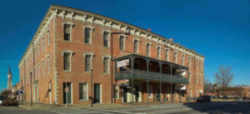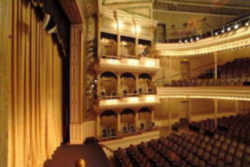
Georgia Symbols
Georgia State Theatre
The Springer Opera House

Adopted in 1992
A historic landmark with antecedents stretching back to Edwin Booth, the Springer Opera House was built in 1871 in Columbus, GA, and stands as the state's official theatre. After quite a checkered existence, the theatre was renovated over a two year period, from 1997 through 1999. The goal was to restore the public areas and auditorium to the way they were in 1901, yet add totally modern stage equipment and technical systems.
Plush seats and marble floors glow under lamp light in a Victorian theatre where legends of stage and politics have performed. Opened in 1871, the Springer Opera House in Columbus has hosted Oscar Wilde, William Jennings Bryan, Booker T. Washington, Will Rogers and scores of dramas, operas and concerts. Restored in the 1960's, the Opera House was named a National Historic Landmark in 1978. Governor Jimmy Carter proclaimed it the State Theatre of Georgia for the 1971-72 season.
Georgia State Theatre: The Springer Opera House

The Springer Opera House, the State Theatre of Georgia
and a leading Southern cultural institution for 141 years. As you stroll from the gaslit street into the splendid Edwardian Grand Lobby, you can easily
imagine the Nineteenth Century merchants, tradesmen, farmers, steamboat passengers and arts patrons streaming into the theatre eager to catch their
first glimpse of Oscar Wilde, Ma Rainey or Lillie Langtry.
This spectacular American treasure was built by Francis Joseph Springer, an immigrant from Alsace who moved to Columbus before the Civil War. Springer
became prosperous in the grocery business but had brought his love of theatre, music and dance from his native Rhine River Valley to the burgeoning
Chattahoochee River Valley and dreamt of building a European style theatre here on the banks of this great Southern waterway.
The Springer Opera House opened February 21, 1871 and soon became nationally known as the finest house between Washington and New Orleans.
As you gaze around the opulent main hall with its curving double balconies, delicate tulip lights and high proscenium arch, imagine sitting beneath
the glow of the flickering gaslight watching the legendary Edwin Booth, band leader John Philip Sousa, matinee idols James O'Neill and Joseph Jefferson
or Barnum's famous General Tom Thumb perform on the deep Springer stage. Or perhaps you've come to see the young Will Rogers, Agnes DeMille, Ethel
Barrymore or Ruth Gordon in one of their signature pieces. As the limelight glows hot, you can almost see the great orators William Jennings Bryan
or Franklin D. Roosevelt delivering lectures on the pressing issues of the day. Like millions of people before you have found, a visit to the Springer
Opera House is a very special experience.
The Springer continued as a major theatre center until the stock market crash of 1929. With the onset of the Great Depression, the vast network of
road companies which provided the lifeblood of American theatre collapsed and the Springer succumbed to the advent of the newest technology, movies.
The great old theatre survived as a movie house for awhile but a lack of maintenance and the eventual decline of Columbus' historic commercial district
began the Springer's slide into near oblivion.
In 1964, the theatre where the Barrymore's and the Booth's performed was slated for demolition. As the wrecking ball hovered above the stage house,
a group of citizens determined to save the Springer aroused community support and began to raise the funds to bring it back to life. When the newly
renovated Springer Opera House reopened in 1965, Southerners once again hurried to their seats beneath the huge brass chandelier to enjoy the very
best in theatre, music and dance.
TODAY
Today, the Springer is one of America's most vibrant professional theatre companies with a popular Mainstage Series, an innovative second-space
series called Studio II, an Academy Series featuring some of this region's most talented student actors and a ten-state regional touring program called
Springer Theatre On Tour. It is also the home of one of the nation's finest training schools for young actors, the Springer Theatre Academy.
In 1998-99, the Springer received a comprehensive, $12 million historic renovation which included areas of the building untouched in the 1964 renovation.
This expanded program space from 35,000 to 75,000 square feet. This splendid preservation project included one of the most ambitious historic interior
treatments of any theatre in America and a complete re-equipping with state-of-the-art lighting, sound, rigging, rehearsal facilities and technical
support equipment.
The beautiful mainstage theatre, Emily Woodruff Hall, is named for a dedicated patron, performer, humanitarian and original trustee who inspired the
1964 renovation.
Georgia Law
The law designating the Springer Opera House as the official Georgia state theater is found in the Georgia Code, Title 50, Chapter 3, Section 50-3-66.
TITLE 50 - STATE GOVERNMENT
CHAPTER 3 - STATE FLAG, SEAL, AND OTHER SYMBOLS
ARTICLE 3 - OTHER STATE SYMBOLS
§ 50-3-66 - State theater
O.C.G.A. 50-3-66 (2010)
50-3-66. State theater
The Springer Opera House is designated as the official Georgia state theater.
The Springer Opera House is designated as the official Georgia state theater.







